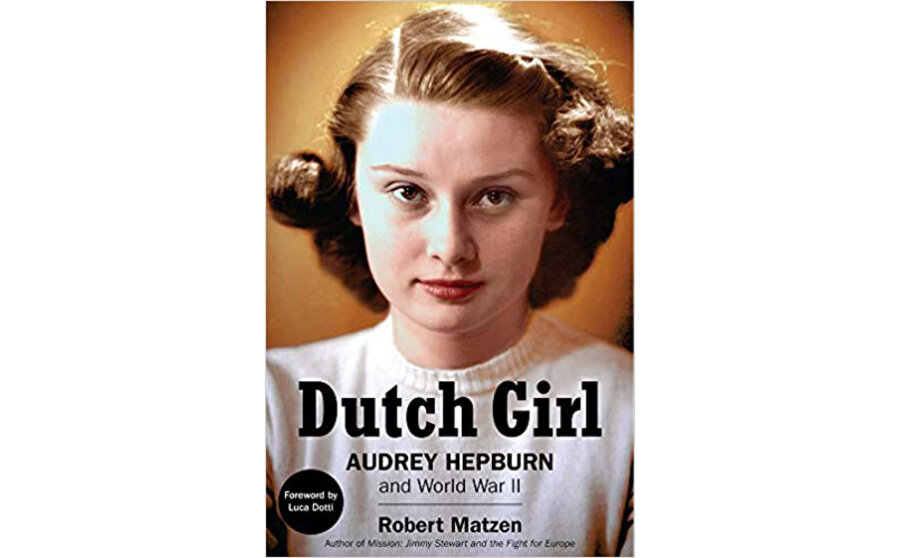‘Dutch Girl’ shows Audrey Hepburn’s wartime courage
Another side of Hepburn emerges in Robert Matzen’s book about her difficult childhood and how it shaped her as an actress and as a humanitarian.

‘Dutch Girl: Audrey Hepburn and World War II’ by Robert Matzen, GoodKnight Books, 373 pp.
May 16, 2019
By Terry Hartle
Audrey Hepburn was one of the most celebrated actresses of the 20th century and a winner of Academy, Tony, Grammy, and Emmy awards. She was a style icon and, in later life, a tireless humanitarian who worked to improve conditions for children in some of the poorest communities in Africa and Asia as an ambassador for UNICEF.
But this extraordinary individual was the product of an extremely difficult childhood. Her father was a British subject and something of a rake and her mother was a minor Dutch noblewoman. Both of her parents flirted with the Nazis in the 1930s. Her mother met Adolf Hitler and wrote favorable articles about him for the British Union of Fascists. After abandoning the family in 1935, her father moved to England and became so active with Oswald Mosley’s fascists that he was interned during World War II. As a child, Hepburn rarely saw him.
Hepburn was shipped off to a small boarding school in England where she fell in love with the world of dance. With the outbreak of the war, her mother brought her back to the Netherlands. There, she became a reluctant observer of the brutal Nazi occupation of Western Europe from 1940 to 1945.
Her early life is the subject of Robert Matzen’s latest book, Dutch Girl: Audrey Hepburn and World War II. This is the third book that Matzen has devoted to leading figures of Hollywood’s Golden Age during the war years. As with his earlier volumes, “Mission: Jimmy Stewart and the Fight for Europe” and “Fireball: Carole Lombard and the Mystery of Flight 3,” this book dives deep into a corner of his subject’s life that gets little attention from most biographers. Matzen believes that what Hepburn, Stewart, and Lombard did during the war is interesting in its own right, and that their experiences fundamentally shaped their lives and provide insights into their characters.
That clearly seems to be the case with Hepburn. She was 11 years old when the Germans invaded the Netherlands and made her hometown of Arnhem a primary base of operation. She experienced the full trauma of the war. She saw Jewish people loaded into train cars for deportation. A beloved uncle was executed in retaliation for resistance activities. One of her brothers was deported to a German labor camp and another spent the war in hiding.
Her family suffered from cold, malnutrition, and a lack of medical supplies. Their home was repeatedly damaged by bombing. After the Allies’ June 1944 invasion of Normandy, things got worse. The Dutch railroad workers went on strike to limit the Germans’ ability to resupply their frontline troops. But this also deprived the Dutch population of food. Starvation became commonplace, and at one point during the so-called Hunger Winter, Hepburn was so weak she gave up dancing. Nonetheless, she tried to pass her meager food rations to her mother and relatives.
Things would get worse: Operation Market Garden, the effort by British paratroopers to capture the bridge over the Rhine at Arnhem, brought the war to her front door. There was heavy fighting on the street where she lived while her family cowered in the basement.
Hepburn began helping the Resistance despite the clear penalties for those who were caught. She ran messages and, at one point, her family hid a British soldier and helped him escape. Already a gifted dancer, she performed in benefit events to help raise money for the resistance. These were called “black evenings” because the windows where the events took place were blacked out and silence prevailed. Hepburn would later say of these events that “the best audiences I ever had made not a single sound at the end of my performance.”
After the war, Hepburn moved first to Amsterdam to study ballet with Sonia Gaskell and later to London where she studied with Marie Rambert. She hoped to become a prima ballerina but at 5 feet, 7 inches, she was too tall. Moreover, she lacked the physical stamina for such roles, probably the result of sustained malnutrition during the war. Eventually, she turned to the stage and began dancing as a chorus girl. Before long, she started work as an actress and her career blossomed.
This book, like the others in Matzen’s so-called Hollywood trilogy, is a hybrid. Despite extensive research, it is not a complete biography because it only examines one part of Hepburn’s life, albeit in great detail. Nor is it as fully satisfying as a history because it focuses on events primarily as Hepburn experienced them.
But it offers a wonderfully complete and revealing character sketch of an individual who continues to fascinate millions around the world. Hepburn was, of course, gracious, talented, and elegant. But Matzen makes clear that she also was extraordinarily courageous. While being tested in the most difficult ways imaginable at a very young age, Hepburn demonstrated incredible poise, bravery, and selflessness. Little wonder that, having suffered so much herself as a child, after retiring from acting, she devoted her life to improving the lives of children living in terribly difficult circumstances. This entertaining and enlightening book adds another dimension to the legend of Audrey Hepburn.
No comments:
Post a Comment